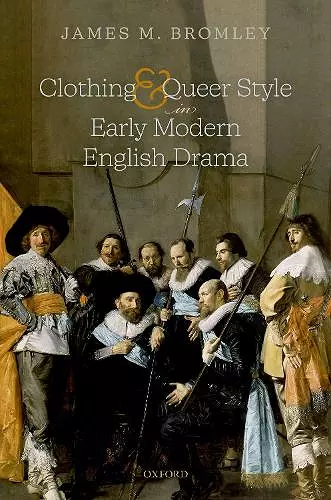Clothing and Queer Style in Early Modern English Drama
Format:Hardback
Publisher:Oxford University Press
Published:27th May '21
Should be back in stock very soon

This book examines early modern drama's depiction of non-standard forms of masculinity grounded in superficiality, inauthenticity, affectation, and the display of the extravagantly clothed body. Practices of extravagant dress destabilized distinctions between able-bodied and disabled, human and non-human, and the past and present, distinctions that structure normative ways of thinking about sexuality. In city comedies by Ben Jonson, George Chapman, Thomas Middleton, and Thomas Dekker, extravagantly dressed male characters imagine alternatives to the prevailing modes of subjectivity, sociability, and eroticism in early modern London. While these characters are situated in hostile narrative and historical contexts, this book draws on recent work on disability, materiality, and queer temporality to rethink their relationship to those contexts in order to access the world-making possibilities of early modern queer style. In their rich representations of life in London around the turn of the seventeenth century, these plays not only were, but also remain, uniquely sensitive to the intersection of sexuality, urbanization, and material culture. The attachments and pleasures of early modern sartorial extravagance they depict can estrange us from the epistemologies that narrow current thinking about sexuality's relationship to authenticity, pedagogy, interiority, and privacy.
The book's playfulness makes it an often enjoyable read. Without wishing to spoil the opening of chapter 4 for future readers, I will say that in a field somewhat saturated with reappropriations of Greenblatt's desire to speak with the dead, this particular chapter opening is by far the one that has made me laugh the most. * Kit Heyam, Queen Mary, University of London, Early Theatre *
It is exemplary in bringing together scholarship from many different disciplines, and using it to push the boundaries of what we think of as dress history. His challenge of queerphobic and sex-negative history-making brings a powerful message to re-examine our personal biases and imagine a better and more diverse past, and then bring that thinking to the present and future. * Luise Kocaurek, Journal of Dress History *
The book thus masterfully interweaves critical theory with analysis grounded in historical context...For those teaching or researching themes of construction of the self, embodiment, gender identity, and theatricality, there will be much to ponder after reading this thoughtful and surprising study. * John S. Garrison, Grinnell College, Renaissance and Reformation *
Beyond its elegant analyses of queer style, the book proposes concepts of "queer worldmaking" and "cruisy historicism" (the latter developed in chapter 4) to enable new ways of understanding past and present articulations of embodiment nd desire...This template, as indeed the book as a whole, will doubtless prove indispensable for queer critics within and well beyond the field of early modern studies. * David L. Orvis, Appalachian State University, Renaissance Quarterly *
Romley's investment in seeing early modern drama as a site for the promulgation of queer life possibilities is vital and inspiring, and his framing of queer style as 'pedagogical' is an important step forward for early modern sexuality studies, which has recently begun to think about the ways that we learn how to be ourselves. Beyond its important contributions to queer studies, this book will also be of great interest to those interested in city comedy, material culture, and masculinity, and Bromley's focus on non-Shakespearean drama is most welcome. * Joseph Gamble, University of Toledo, Shakespeare Bulletin *
ISBN: 9780198867821
Dimensions: 241mm x 165mm x 19mm
Weight: 512g
240 pages